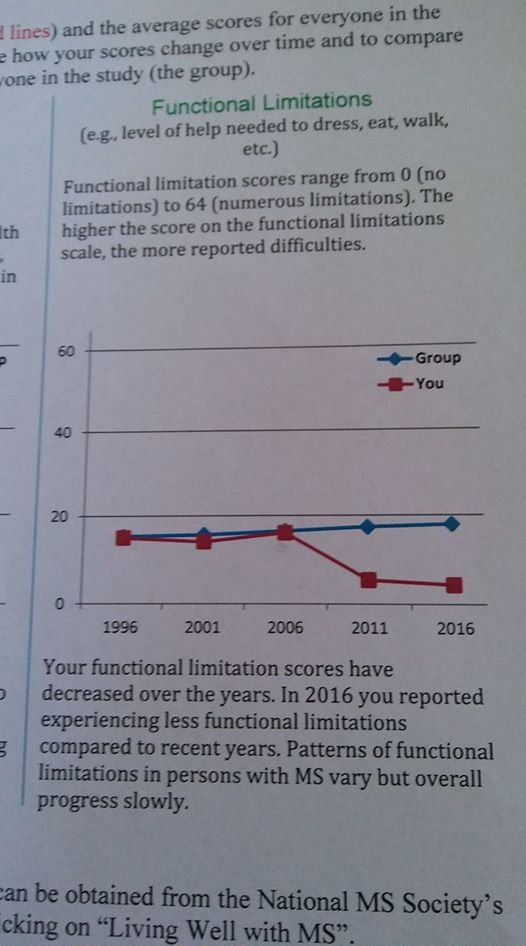Sometimes MS can be CURED. Amy's was.

Yes, you heard it right, it is possible to cure MS. The method is not without risks, but then, many MS meds are pretty dangerous too, so it is a matter of weighing the risks versus the potential benefits. The goal is to reset the immune system so that it does not remember deciding to target a part of the patient’s own body as an enemy. If this is accomplished, the person will never have to take MS medications again, and it will completely stop the progression of damage to the nervous system. Of course, the damage that has already been done is not magically reversed, but the disease is halted in its tracks and the portion of the symptoms that are due to inflammation goes away as well. My friend Amy is living proof that this CAN happen. This is her graph.
The complete story of my friend Amy’s partnership with doctors in Russia and prayer warriors all over the world to use hematopoietic stem cell transplantation (HSCT) therapy to reset her immune system can be found on her entertaining blog (she is an excellent writer): https://amygoesninja.wordpress.com/2011/12/
Amy writes, " In 2011, I did not participate in the study because I was too ill to make it happen (it is a lengthy survey and office visit.) My Russian adventure was in 2012 and I did not see improvement until then. Not sure exactly why this chart shows 2011, but perhaps it's because I skipped that year? Whatevs. I am 1 of 900 who have stuck with this study for over 20 years. I have wondered for the last almost 5 years what my graph would look like after HSCT. The researchers know what I have been up to, but can only raise eyebrows and nod enthusiastically, to keep the study clean."
These outstanding results are especially dear to my heart because when Amy was researching HSCT, I was a UTMB PhD student with unlimited library privileges. I was able to confirm that the treatment made scientific sense and that the preliminary results were positive. When she was going through the actual process, I was in Ghana for my dissertation research, only a few time zones off from Moscow. This allowed me to chat with Amy online during some of her lonelier times, when her prayer warrior friends in Texas were asleep.
Over the years, researchers have learned a lot about using HSCT for autoimmune diseases. The patient must be healthy enough to survive the chemo used to destroy the old immune system. Earlier studies tried using donated stem cells, which was less successful than autologous stem cells. When we look at the statistics for HSCT, we find that the mortality rates using current protocols are very, very low now (mortality is lower with HSTC than with gall bladder removal surgery), and the success rates are high - better than 80% LONG-TERM. We have learned who is a good candidate for HSCT and the best methods of providing it. In fact, even the MS Society is beginning to acknowledge that this therapy – which leads to a loss of revenue for their big-pharma sponsors – does have merit.
I hope you take the time to look at the graph. Amy would have been way up at 50 on the scale (she was wheelchair bound) had they recorded her pre-HSCT 2011 results. It would be interesting if they phoned the dropouts and asked why they did not continue with the study, so they could include a paragraph about that in their final report. How many other participants dropped out of this study, not because they moved out of the area, but because their function had become too limited for them to bother with the lengthy survey and physical assessment, or they passed away? It may be that the Group curve actually reflects the best outcomes, rather than the average outcomes. That extra time taken to survey the dropouts would reveal that possibility.
In any case, hurrah for Amy!!!!
P.S. Detailed protocol discussion here: http://themscure.blogspot.com/2011/06/getting-into-hsct-treatment-if-you-have.html